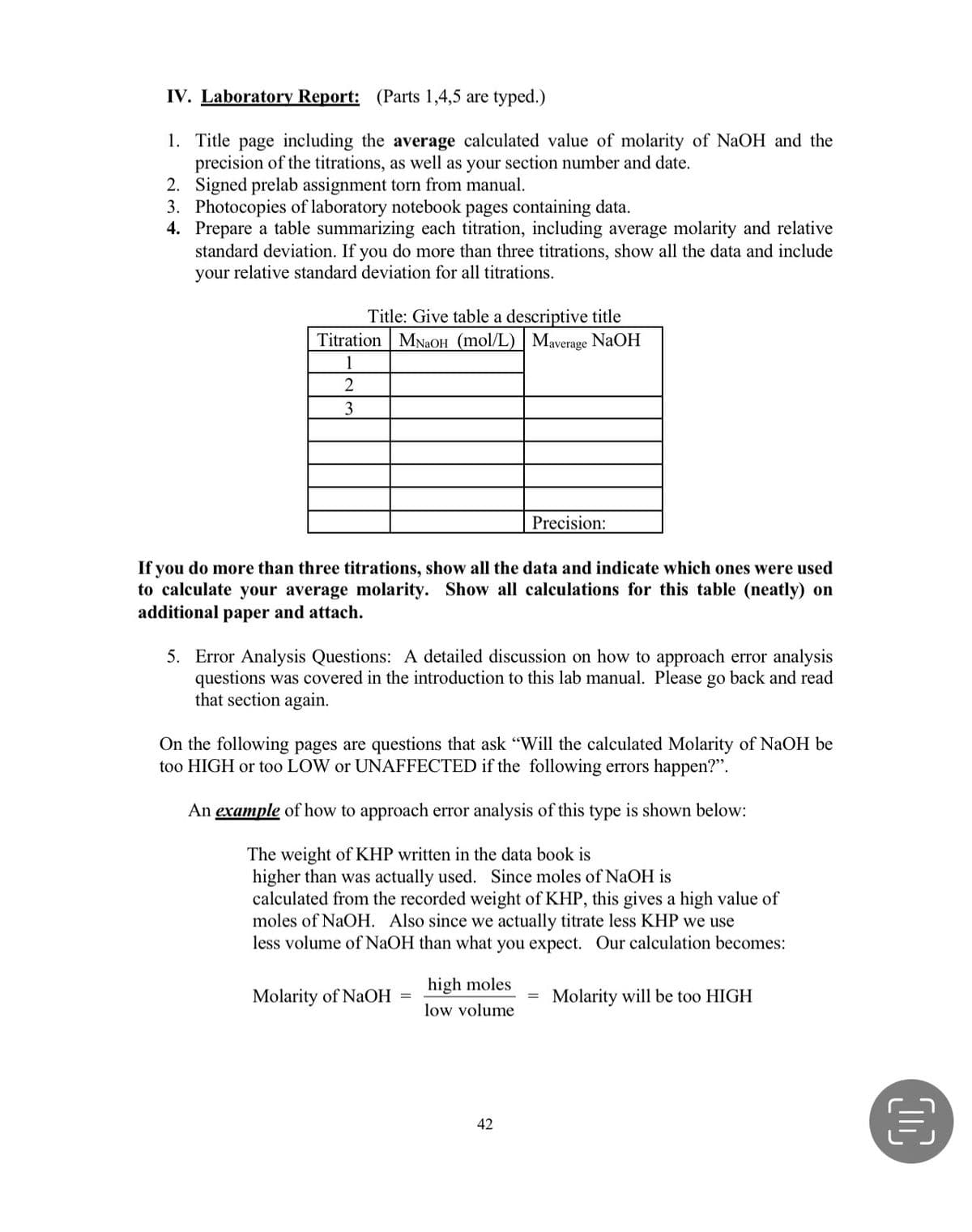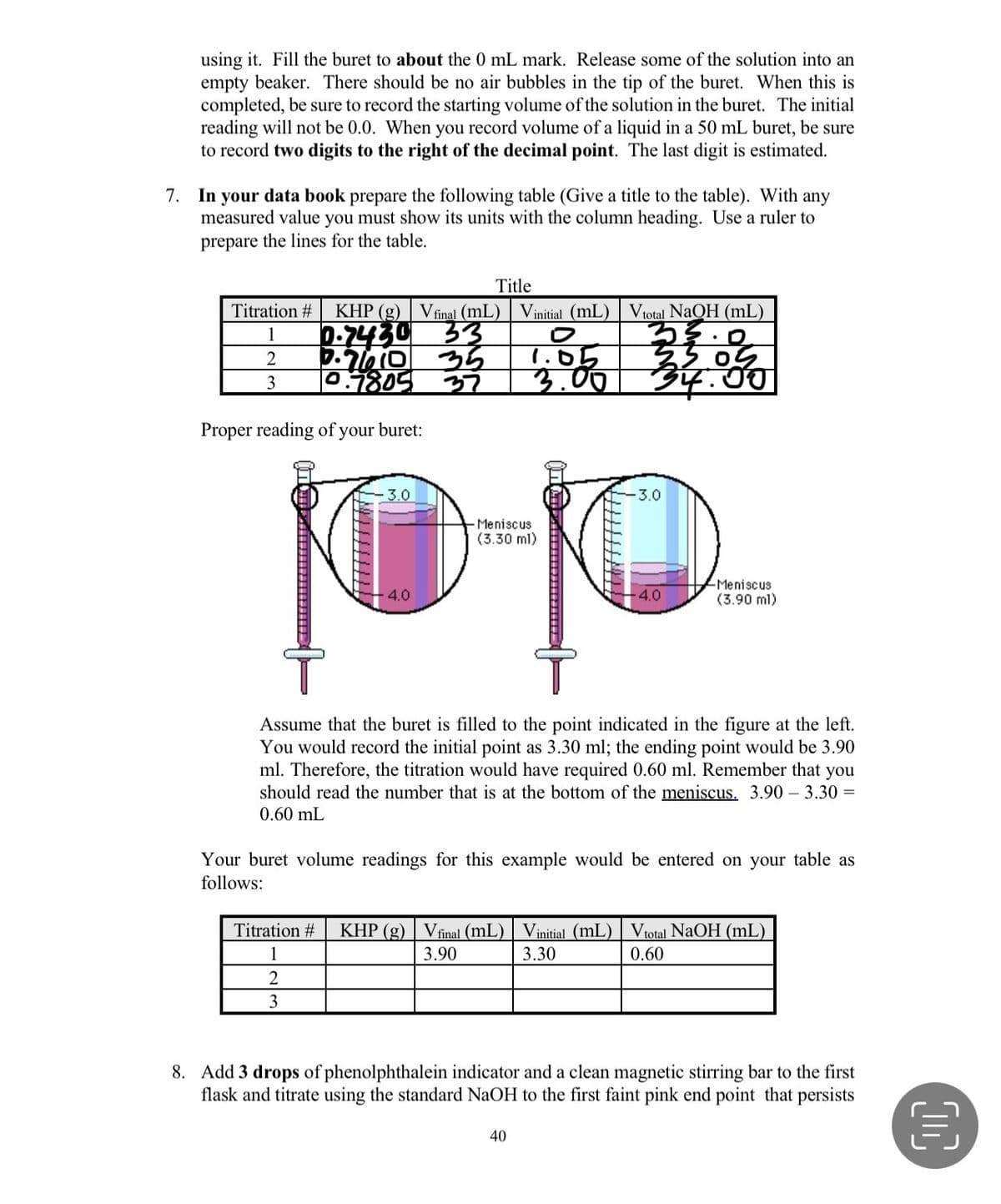IV. Laboratory Report: (Parts 1,4,5 are typed.) 1. Title page including the average calculated value of molarity of NaOH and the precision of the titrations, as well as your section number and date. 2. Signed prelab assignment torn from manual. 3. Photocopies of laboratory notebook pages containing data. 4. Prepare a table summarizing each titration, including average molarity and relative standard deviation. If you do more than three titrations, show all the data and include your relative standard deviation for all titrations. Title: Give table a descriptive title Titration MNaOH (mol/L) Maverage NaOH 1 3 Precision: If you do more than three titrations, show all the data and indicate which ones were used to calculate your average molarity. Show all calculations for this table (neatly) on additional paper and attach. 5. Error Analysis Questions: A detailed discussion on how to approach error analysis questions was covered in the introduction to this lab manual. Please go back and read that section again. On the following pages are questions that ask "Will the calculated Molarity of NaOH be too HIGH or too LOW or UNAFFECTED if the following errors happen?". An example of how to approach error analysis of this type is shown below: The weight of KHP written in the data book is higher than was actually used. Since moles of NaOH is calculated from the recorded weight of KHP, this gives a high value of moles of NaOH. Also since we actually titrate less KHP we use less volume of NaOH than what you expect. Our calculation becomes: high moles Molarity of NaOH Molarity will be too HIGH low volume
IV. Laboratory Report: (Parts 1,4,5 are typed.) 1. Title page including the average calculated value of molarity of NaOH and the precision of the titrations, as well as your section number and date. 2. Signed prelab assignment torn from manual. 3. Photocopies of laboratory notebook pages containing data. 4. Prepare a table summarizing each titration, including average molarity and relative standard deviation. If you do more than three titrations, show all the data and include your relative standard deviation for all titrations. Title: Give table a descriptive title Titration MNaOH (mol/L) Maverage NaOH 1 3 Precision: If you do more than three titrations, show all the data and indicate which ones were used to calculate your average molarity. Show all calculations for this table (neatly) on additional paper and attach. 5. Error Analysis Questions: A detailed discussion on how to approach error analysis questions was covered in the introduction to this lab manual. Please go back and read that section again. On the following pages are questions that ask "Will the calculated Molarity of NaOH be too HIGH or too LOW or UNAFFECTED if the following errors happen?". An example of how to approach error analysis of this type is shown below: The weight of KHP written in the data book is higher than was actually used. Since moles of NaOH is calculated from the recorded weight of KHP, this gives a high value of moles of NaOH. Also since we actually titrate less KHP we use less volume of NaOH than what you expect. Our calculation becomes: high moles Molarity of NaOH Molarity will be too HIGH low volume
Chemistry
10th Edition
ISBN:9781305957404
Author:Steven S. Zumdahl, Susan A. Zumdahl, Donald J. DeCoste
Publisher:Steven S. Zumdahl, Susan A. Zumdahl, Donald J. DeCoste
Chapter1: Chemical Foundations
Section: Chapter Questions
Problem 1RQ: Define and explain the differences between the following terms. a. law and theory b. theory and...
Related questions
Question
Show all the calculations:

Transcribed Image Text:IV. Laboratory Report: (Parts 1,4,5 are typed.)
1. Title page including the average calculated value of molarity of NaOH and the
precision of the titrations, as well as your section number and date.
2. Signed prelab assignment torn from manual.
3. Photocopies of laboratory notebook pages containing data.
4. Prepare a table summarizing each titration, including average molarity and relative
standard deviation. If you do more than three titrations, show all the data and include
your relative standard deviation for all titrations.
Title: Give table a descriptive title
Titration MNaOH (mol/L) Maverage NaOH
1
3
Precision:
If you do more than three titrations, show all the data and indicate which ones were used
to calculate your average molarity. Show all calculations for this table (neatly) on
additional paper and attach.
5. Error Analysis Questions: A detailed discussion on how to approach error analysis
questions was covered in the introduction to this lab manual. Please go back and read
that section again.
On the following pages are questions that ask "Will the calculated Molarity of NaOH be
too HIGH or too LOW or UNAFFECTED if the following errors happen?".
An example of how to approach error analysis of this type is shown below:
The weight of KHP written in the data book is
higher than was actually used. Since moles of NaOH
calculated from the recorded weight of KHP, this gives a high value of
moles of NaOH. Also since we actually titrate less KHP we use
less volume of NaOH than what you expect. Our calculation becomes:
high moles
Molarity of NaOH
Molarity will be too HIGH
low volume
42

Transcribed Image Text:using it. Fill the buret to about the 0 mL mark. Release some of the solution into an
empty beaker. There should be no air bubbles in the tip of the buret. When this is
completed, be sure to record the starting volume of the solution in the buret. The initial
reading will not be 0.0. When you record volume of a liquid in a 50 mL buret, be sure
to record two digits to the right of the decimal point. The last digit is estimated.
7. In your data book prepare the following table (Give a title to the table). With any
measured value you must show its units with the column heading. Use a ruler to
prepare the lines for the table.
Title
Titration #
KHP (g) Vfinal (mL) | Vinitial (mL) | Vtotal NaOH (mL)
33
36
3.
D-7430
1
22.05
14.00
2
1.05
|0.7805 37
3
Proper reading of your buret:
3.0
3.0
- Meniscus
(3.30 ml)
Meniscus
(3.90 ml)
4.0
4.0
Assume that the buret is filled to the point indicated in the figure at the left.
You would record the initial point as 3.30 ml; the ending point would be 3.90
ml. Therefore, the titration would have required 0.60 ml. Remember that you
should read the number that is at the bottom of the meniscus. 3.90 – 3.30 =
0.60 mL
Your buret volume readings for this example would be entered on your table as
follows:
Titration #
KHP (g) Vfinal (mL) Vinitial (mL) Vtotal NAOH (mL)
1
3.90
3.30
0.60
2
3
8. Add 3 drops of phenolphthalein indicator and a clean magnetic stirring bar to the first
flask and titrate using the standard NaOH to the first faint pink end point that persists
40
Expert Solution
This question has been solved!
Explore an expertly crafted, step-by-step solution for a thorough understanding of key concepts.
This is a popular solution!
Trending now
This is a popular solution!
Step by step
Solved in 6 steps

Knowledge Booster
Learn more about
Need a deep-dive on the concept behind this application? Look no further. Learn more about this topic, chemistry and related others by exploring similar questions and additional content below.Recommended textbooks for you

Chemistry
Chemistry
ISBN:
9781305957404
Author:
Steven S. Zumdahl, Susan A. Zumdahl, Donald J. DeCoste
Publisher:
Cengage Learning

Chemistry
Chemistry
ISBN:
9781259911156
Author:
Raymond Chang Dr., Jason Overby Professor
Publisher:
McGraw-Hill Education

Principles of Instrumental Analysis
Chemistry
ISBN:
9781305577213
Author:
Douglas A. Skoog, F. James Holler, Stanley R. Crouch
Publisher:
Cengage Learning

Chemistry
Chemistry
ISBN:
9781305957404
Author:
Steven S. Zumdahl, Susan A. Zumdahl, Donald J. DeCoste
Publisher:
Cengage Learning

Chemistry
Chemistry
ISBN:
9781259911156
Author:
Raymond Chang Dr., Jason Overby Professor
Publisher:
McGraw-Hill Education

Principles of Instrumental Analysis
Chemistry
ISBN:
9781305577213
Author:
Douglas A. Skoog, F. James Holler, Stanley R. Crouch
Publisher:
Cengage Learning

Organic Chemistry
Chemistry
ISBN:
9780078021558
Author:
Janice Gorzynski Smith Dr.
Publisher:
McGraw-Hill Education

Chemistry: Principles and Reactions
Chemistry
ISBN:
9781305079373
Author:
William L. Masterton, Cecile N. Hurley
Publisher:
Cengage Learning

Elementary Principles of Chemical Processes, Bind…
Chemistry
ISBN:
9781118431221
Author:
Richard M. Felder, Ronald W. Rousseau, Lisa G. Bullard
Publisher:
WILEY